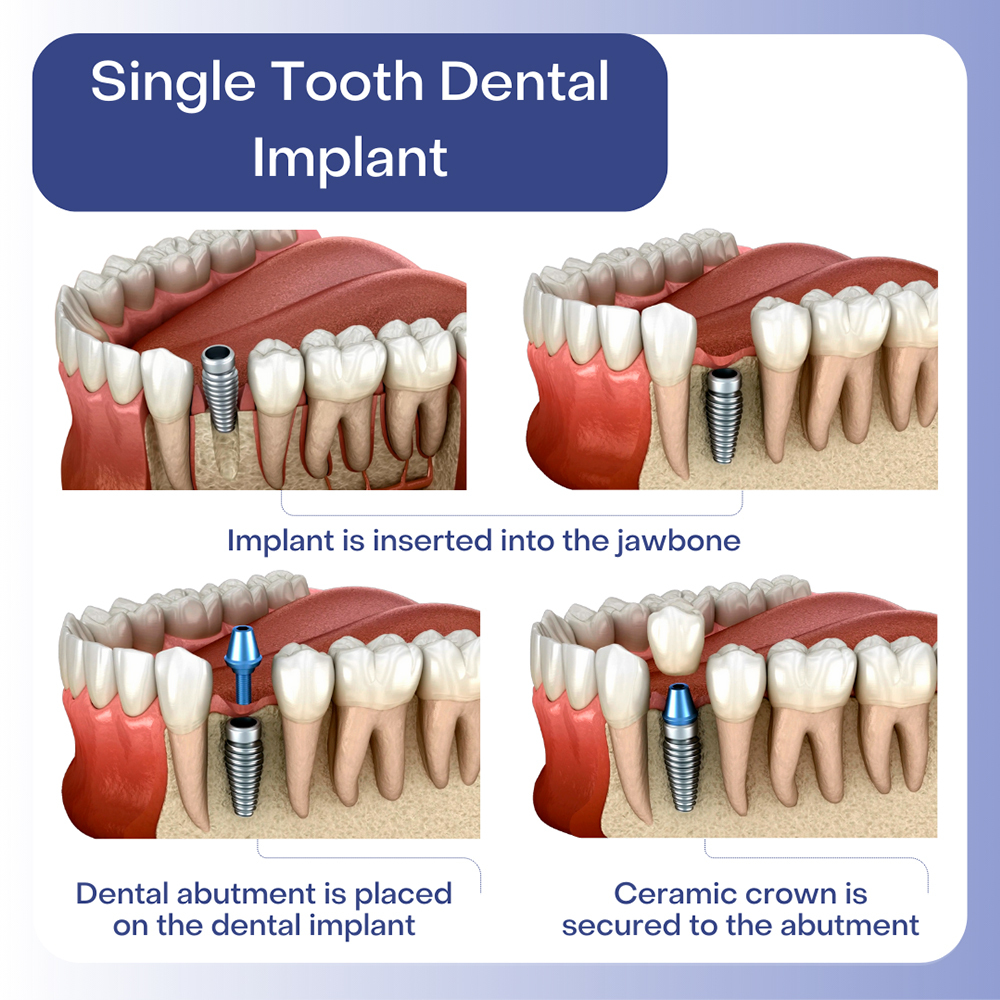What Does Dental Sense Do?
What Does Dental Sense Do?
Blog Article
3 Easy Facts About Dental Sense Shown
Table of ContentsThe Basic Principles Of Dental Sense Some Ideas on Dental Sense You Need To KnowThe Only Guide to Dental SenseAll About Dental Sense
are medical devices operatively dental implanted into the jaw to restore an individual's capability to chew or their appearance. They offer support for synthetic (fake) teeth, such as crowns, bridges, or dentures. When a tooth is shed due to injury or illness, a person can experience complications such as quick bone loss, defective speech, or modifications to eating patterns that result in discomfort.Dental implant systems consist of an oral implant body and dental implant joint and might additionally include a joint fixation screw. Front tooth filling. The oral implant body is surgically placed in the jawbone instead of the tooth's root. The oral implant joint is normally affixed to the dental implant body by the joint addiction screw and prolongs with gum tissues into the mouth to sustain the affixed man-made teeth
(https://linktr.ee/dentalsense1)Framework of The Oral Implant System selecting dental implants, speak to your dental copyright about the prospective advantages and dangers, and whether you are a candidate for the procedure. Things to think about: Your total wellness is a crucial consider determining whether you are a great prospect for oral implants, exactly how long it will take to recover, and the length of time the dental implant might remain in area.
Cigarette smoking may influence the healing procedure and lower the lasting success of the dental implant. The recovery process for the dental implant body might take numerous months or longer, during which time you commonly have a short-lived joint instead of the tooth. the oral implant procedure: Carefully comply with the oral hygiene instructions offered to you by your dental supplier.
Our Dental Sense PDFs
Implant failure can lead to the requirement for an additional surgery to repair or replace the implant system. Restores the capability to eat Brings back aesthetic look Assists keep the jawbone from reducing because of bone loss Maintains the health and wellness of the surrounding bone and periodontals Assists keep adjacent (neighboring) teeth steady Boosts quality of life Damage to bordering natural teeth throughout implant positioning Injury to the surrounding cells during surgical treatment, such as sinus perforation Injury throughout surgery (for example, crack of bordering jawbone) Inadequate function, such as seeming like the teeth do not bite together typically An experience that the tooth is loose or twisting in location resulting from an abutment screw loosening up Implant body failure (looseness of the implant body) due to systemic infection, which might be more probable in individuals with unchecked diabetes because of regional infection in bone and gum tissues supporting the implant body as a result of postponed healing, which might be much more likely in patients who smoke Difficulty cleaning the gums around the implant, leading to inadequate dental health Without treatment periodontal disease Post-surgical numbness because of nerve impingement or damages Always notify healthcare suppliers and imaging service technicians that you have dental implants prior to any kind of magnetic vibration imaging (MRI) or x-ray procedures.
FDA is not conscious of any kind of negative occasions reported for MRI or x-ray treatments with oral implants. Oral implants systems are usually made of materials that comply with international agreement requirements of the International Organization for Standardization (ISO) or ASTM International. These criteria have information of what makes a risk-free product.

A dental implant is a structure that changes a missing out on tooth. With screw-like tools, the doctor inserts an implant into the jawbone, and it acts as an anchor for a fabricated tooth, called a crown. A device called an abutment attaches the artificial tooth to the dental implant. The crown is custom-made to fit the individual's mouth and match the shade of their teeth.
7 Simple Techniques For Dental Sense
Some people are not qualified for oral implant surgery. It is for dental cosmetic surgeons to operate on individuals with: acute illnessuncontrollable metabolic diseasebone or soft cells condition or infectionIf these problems are settled, a person can have the surgical treatment. In, oral surgeons abstain from running on people with: If individuals with any of the above undertake oral implant surgery, there is a greater threat of the dental implant falling short.

Dental implant surgery is a personalized procedure. It's not the very same for everybody. The following provides a general overview of what you can anticipate your dental practitioner, dental specialist, periodontist or prosthodontist to do: Position the dental implant surgically. Offer you time to heal. Attach the article and final crown, bridge or denture.
Next, your cosmetic surgeon will carefully put the oral implant into your jaw. If your implant is near the front of your mouth, your dental practitioner will make a temporary tooth for you to put on up until you recover.
Dental Sense for Dummies
Your provider can tell you what to anticipate in your situation. Throughout the recovery phase, your jawbone should fuse to the dental implant. This procedure, called osseointegration, is vital for stability and long-lasting success. This process can take anywhere from 3 to nine months. In many cases, it might take much longer.
Once your dental implant heals, your dental practitioner can affix the joint (little adapter post) and your final reconstruction (crown, bridge or denture). This generally takes concerning one hour to finish and might need a 2nd minor surgical procedure. You should not really feel any pain during your oral implant procedure since your company will certainly utilize medicine to numb your periodontals.
Report this page